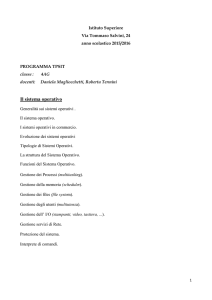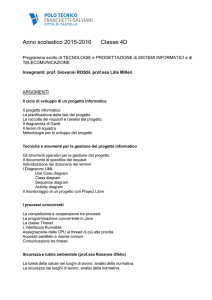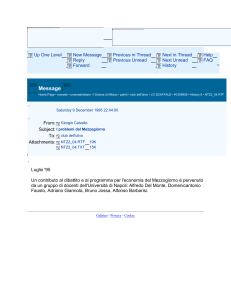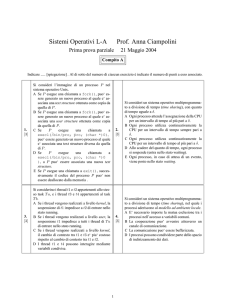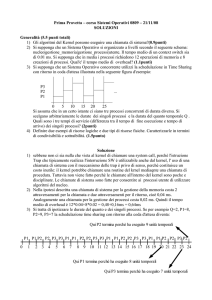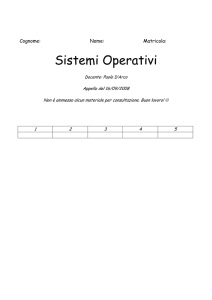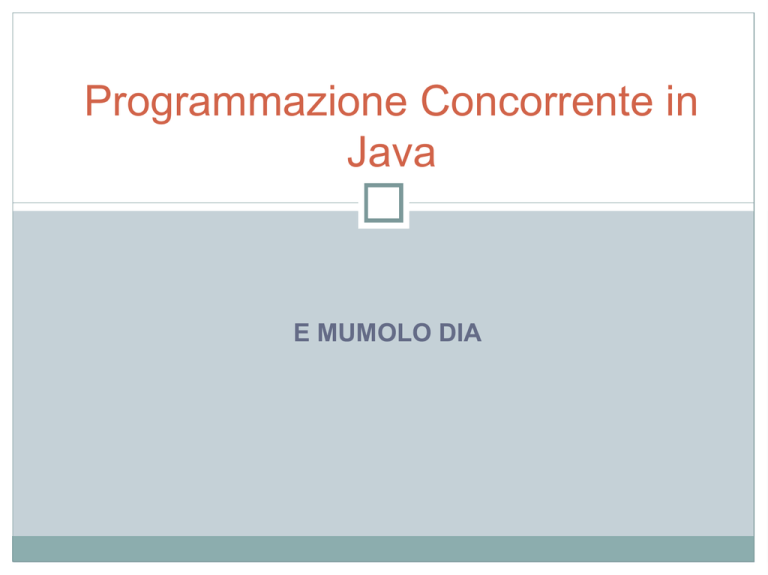
Programmazione Concorrente in
Java
E MUMOLO DIA
Multithreading in Java
Ogni thread e’ un oggetto, creato come istanza della classe java.lang.Thread
La classe Thread contiene tutti i metodi per gestire i threads
L’utente implementa il metodo run()
Uno dei metodi piu’ importanti e’ il metodo start() che lancia il thread utilizzando
il metodo run definito dall’utente
Ogni istanza di Thread deve quindi essere associata ad un metodo run
Ci sono due metodi per realizzare un thread:
Implementando l’interfaccia Runnable
L'interfaccia contiene il solo metodo public void run()
Estendendo la classe java.lang.Thread e sovrascrivendo il metodo run()
Un thread termina quando
Finisce
Viene eseguito il metodo stop() del thread
Scatta una eccezione
Lo scheduling e’ basato sullle priorita’ (metodo setPriority())
A parita’ di priorita’ → round-robin
Preemptive
http://java.sun.com/docs/books/tutorial/essential/concurrency/
Un programma Multithreaded
• Main Thread
• start
• Thread A
• start
• start
• Thread B
• Thread C
Processi a Thread singolo e a
Thread multipli
• I Thread sono dei processi che eseguono all'interno di un processo
• Processo con singolo Thread
• Processo con Thread multipli
• Thread in
• esecuzione
• Spazio di indirizzamentocomune
Multithreading in Java
Creazione ed esecuzione di un Thread in Java:
Thread t = new Thread();
t.start();
Questo thread non ha codice e si ferma subito. Come si indica il codice del Thread?
Ci sono due modi:
Mediante creazione di una classe derivata:
public class MioThread extends Thread {
public void run(){
System.out.println("Sono MioThread ");
}
}
MioThread t = new MioThread();
t.start();
Mediante implementazione classe Runnable
public class MioRunnable implements Runnable {
public void run(){
System.out.println("Sono MioRunnable ");
}
}
Thread t = new Thread(new MioRunnable());
t.start();
Esempio mediante classe derivata
class MyThread extends Thread { // il thread
public void run() {
System.out.println(" … questo thread sta eseguendo ... ");
}
} // class MyThread
class ThreadEx1 {
// un programma che utilizza il thread
public static void main(String [] args ) {
MyThread t = new MyThread();
// ora chiamo start e questo chiama il metodo run.
t.start();
} // end main()
}
Esempio mediante
implementazione interfaccia
class MyThread implements Runnable {
public void run() {
System.out.println("..questo thread è in esecuzione... ");
}
} // fine class MyThread
class ThreadEx2 {
public static void main(String [] args ) {
Thread t = new Thread(new MyThread());
// ora chiamo start e questo chiama run
t.start();
}
}
Altro esempio mediante creazione subclass 1
import java.io.*;
public class PingPong2{
// il main crea e lancia i thread
public static void main(String[] a){
Ping2 c=new Ping2(); c.start(); Pong2 t=new Pong2(); t.start();
}
}
class Ping2 extends Thread{
public void run(){
while(true) {
try{ Thread.sleep(800); } catch(InterruptedException e) {}
System.out.println("sono un thread creato dal main");
}
}
}
class Pong2 extends Thread{
public void run(){
while(true) {
try{ Thread.sleep(990); } catch (InterruptedException e){}
System.out.println("\tsono un thread creato dal main");
}
}
}
Altro esempio mediante creazione subclass 2
import java.io.*;
public class PingPong3{
public static void main(String[] a){
Ping3 c=new Ping3(); Pong3 t=new Pong3();
}
}
class Ping3 extends Thread{ //ogni thread si lancia da solo
public void run(){
while(true) {
try{ Thread.sleep(800); } catch(InterruptedException e) {}
System.out.println("sono un thread creato dal main");
}
}
Ping3(){ start(); }
}
class Pong3 extends Thread{
public void run(){
while(true) {
try{ Thread.sleep(990); } catch (InterruptedException e){}
System.out.println("\tsono un thread creato dal main");
}
}
Pong3(){ start(); }
}
Altro esempio:
mediante implementazione Runnable 1
import java.io.*;
public class PingPong{
//il main crea e lancia i thread
public static void main(String[] a){
Ping c=new Ping(); Pong t=new Pong();
–
Thread th1=new Thread(c); th1.start();
Thread th2=new Thread(t); th2.start();
}
}
class Ping implements Runnable{
public void run(){
while(true) {
try{ Thread.sleep(800); } catch(InterruptedException e) {}
System.out.println("sono un thread creato dal main");
}
}
}
class Pong implements Runnable{
public void run(){
while(true) {
try{ Thread.sleep(990); } catch (InterruptedException e){}
System.out.println("\tsono un thread creato dal main");
}
}
}
Altro esempio:
mediante implementazione Runnable 2
import java.io.*;
public class PingPong1{
// file PingPong1.java
public static void main(String[] a){
Ping1 c=new Ping1(); Pong1 t=new Pong1();
}
}
class Ping1 implements Runnable{ //file Ping1.java. Ogni oggetto crea e lancia il proprio thread
Thread th;
public void run(){
while(true) {
try{ Thread.sleep(800); } catch(InterruptedException e) {}
System.out.println("sono un thread creato dal main");
}
}
Ping1() {th=new Thread(this); th.start();}
}
class Pong1 implements Runnable{ //file Pong1.java
Thread th;
public void run(){
while(true) {
try{ Thread.sleep(990); } catch (InterruptedException e){}
System.out.println("\tsono un thread creato dal main");
}
}
Pong1(){ th=new Thread(this); th.start(); }
}
Alcuni metodi della classe Thread
public void start()
//lancia il thread
public void run()
//esegue il codice
public final void stop()
//distrugge il thread
public final void suspend()
//sospende il thread
public final void resume()
//riattiva il thread
public static void sleep(long n)
//sospende il thread per n ms
public final void setPriority(int priority)
//modifica la priorita’
public final int getPriority()
//ottiene la priorità corrente
public static void yield()
//rischedula
public final native boolean isAlive()
//esce con true se il thread è vivo
…
Esempio
public class MyThread extends Thread{
private Thread ThrPrincipale;
public MyThread(){
ThrPrincipale = Thread.currentThread();
}
public void run(){
for (int i=0;i<10; i++) {
PrintMsg();
}
}
public void PrintMsg(){
Thread t = Thread.currentThread();
if( t== ThrPrincipale)
System.out.println(“sono il thread principale”);
else if ( t == this )
System.out.println(“sono il nuovo thread!”);
else System.out.println(“Non so chi sono!”);
}
public static void main(String[] args) {
MyThread tt = new MyThread();
tt.start();
for(int i=0; i<10;i++) tt.PrintMsg();
}
}
Suspend/Stop/Resume
import java.io.*;
class Ping implements Runnable{
public void run(){
while(true) {
try{ Thread.sleep(800);
} catch(InterruptedException e) {}
System.out.println("Ping");
}
}
public static void main(String[] a) throws Exception{
Ping c = new Ping();
Thread th1=new Thread(c);
System.out.println("esegue");
th1.start();
System.out.println("sospende");
th1.suspend();
// fai qualcosa...
Th1.resume();
}
}
Suspend/Stop/Resume
import java.io.*;
class Ping implements Runnable{
public void run(){
while(true) {
try{ Thread.sleep(800);
} catch(InterruptedException e) {}
System.out.println("Ping");
}
}
public static void main(String[] a) throws Exception{
Ping c = new Ping();
Thread th1=new Thread(c);
System.out.println("stop");
th1.start();
//
th1.stop();
System.out.println("il thread e' stato fermato");
th1.join();
}
}
Stop/Suspend/Resume
Attenzione:
Stop() e suspend(): rischio di STALLO!!
Supponiamo che il thread avesse acquisito una risorsa in mutua esclusione!
Dal JDK 1.2 stop(), suspend() e resume() → deprecated
Usare wait() e notify() !
La JVM associa ad ogni oggetto che chiama l'istruzione synchronized un LOCK.
Funzione della wait():
- rilascia il LOCK → wait() deve essere inserita in un metodo synchronized
- inserisce il thread in coda d'attesa
- mette il thread in stato NotRunnable
Esempio:
Public synchronized void Esempio(){
if(!condizione) try
{
wait();
} catch(InterruptedException e)
{System.out.println("eccezione di wait!");}
}
Setpriority/getpriority
import java.io.*;
class Ping implements Runnable{
public void run(){
while(true) {
//ricava la Priorita' del thread
System.out.println( th.getName()+" attuale "+th.getPriority());
//cambia la priorita'
th.setPriority(Thread.MAX_PRIORITY);
//ricava la Priorita' del thread
System.out.println(th.getName()+" nuova "+th.getPriority());
}
}
public static void main(String[] a) throws Exception{
Ping c = new Ping();
Thread th1=new Thread(c);
System.out.println("esegue");
th1.start();
}
}
Yield
import java.util.List;
public class YieldEsempio {
public static void main(String a[]){
for(int i=0;i<3;i++){
Simple tt = new Simple(i+5);
tt.start();
}
}
}
class Simple extends Thread{
private int stopCount;
public Simple(int count){
this.stopCount = count;
}
public void run(){
for(int i=0;i<15;i++){
if(i%stopCount == 0){
System.out.println(" in " + i + ", " + getName() + " sta cedendo il
controllo a ...");
yield();
}
}
}
}
isAlive
import java.io.*;
class Ping implements Runnable{
public void run(){
Thread th = Thread.currentThread();
//Tests if this thread is alive
System.out.println(th.isAlive());
}
public static void main(String[] a) throws Exception{
Ping c = new Ping();
Thread th=new Thread(c);
th.start();
th.join();
System.out.println(th.isAlive());
}
}
Uscita:
$java Ping
true
false
$
Stati di un Thread
yield()
new Thread()
New
thread
suspend()
sleep()
wait()
start()
Runnable
stop()
stop()
run()
exit
Dead
resume()
notify()
stop()
Not
Runnable
Passaggio di parametri tra Thread
• Mediante visibilità delle variabili (attribuzione public static)
• Possibile solo per piccoli programmi
import java.io.*;
public class PingPong2{ // il main crea e lancia i thread
public static int numero=0;
public static void main(String[] a){
Ping2 c=new Ping2(); c.start();
Pong2 t=new Pong2(); t.start();
}
}
class Ping2 extends Thread{
public void run(){
while(true) {
try{ Thread.sleep(800); } catch(InterruptedException e) {}
PingPong2.numero++; System.out.println("Ping "+PingPong2.numero);
}
}
}
class Pong2 extends Thread{
public void run(){
while(true) {
try{ Thread.sleep(990); } catch (InterruptedException e){}
PingPong2.numero++; System.out.println("\tPong " +PingPong2.numero);
}
}
}
Passaggio di parametri tra Thread
• PER PROGRAMMI PIU' GRANDI → CONDIVISIONE DI UNA CLASSE DATI
• Tutti i thread devono condividere un oggetto, che contiene i dati e i metodi
• La condivisione viene effettuata mediante definizione del puntatore all’oggetto in ciascun
thread, e mediante l’inizializzazione del puntatore all’oggetto
• L’oggetto in realta’ viene allocato nella classe principale (quella che contiene il main)
• Esempio: due thread – p1 e p2 – che si scambiano 5 reali, con ritardo (genera
sequenzialita’ quindi in questo caso non ci sono problemi di mutua esclusione)
public class pth{
public static void main(String[] a){
z buf=new z();
p1 c=new p1(buf); p2 t=new p2(buf);
c.start(); t.start();
}
}
• Definizione della classe z:
import java.io.*;
public class z{
float b[]= new float[10];
void put(int i, float f)
{ b[i]=f; }
float get(int I)
{ return(float)b[i];
}
}
Esempio: produttore/consumatore
import java.io.*;
import java.util.*;
class mypc
// Classe principale contentene il main
{
static Buffer buf=new Buffer();
public static void main(String Arg[])
{
Prod a=new Prod(buf);
Cons b=new Cons(buf);
Cons1 c=new Cons1(buf);
a.start();
b.start();
c.start();
}
}
class Buffer
// Classe che realizza il buffer condiviso
{
private int buf[]=new int [5];
private int in;
private int out;
Buffer () { in=0; out=0;}
int get_in() { return in; }
int get_out() { return out; }
int get_buf() { return buf[out]; }
void put_in (int a) { in=a; }
void put_out (int a) { out=a; }
void put_buf (int a) { buf[in]=a; }
}
class Prod extends Thread // Classe che realizza il thread produttore
{
Buffer b;
Random r;
Prod(Buffer p){ this.b=p; r=new Random(); }
public void run(){
int el;
while (true){
el=r.nextInt(); // Nuova produzione
while(b.get_out()==((b.get_in()+1)%5))
{System.out.print("");};//Buffer pieno?
b.put_buf(el);
System.out.println("P - Ho prodotto: "+el);
b.put_in((b.get_in()+1)%5);
}
}
}
class Cons extends Thread // Classe che realizza il thread del consumatore1
{
Buffer b;
Cons(Buffer p) { this.b=p; }
public void run()
{
while(true)
{
int el;
while(b.get_in()==b.get_out()) {System.out.print("");};//Buffer vuoto?
el=b.get_buf();
System.out.println("C1 - Ho consumato: " + el + " OUT=" + b.get_out());
b.put_out((b.get_out()+1)%5);
}
}
}
class Cons1 extends Thread
// Classe che realizza il thread del consumatore2
{
Buffer c;
Cons1(Buffer p) { this.c=p; }
public void run()
{
while(true)
{
int el;
while(c.get_in()==c.get_out()) {System.out.print("");};//Buffer vuoto?
el=c.get_buf();
System.out.println("C2- Ho consumato: " + el + " OUT=" + c.get_out());
c.put_out((c.get_out()+1)%5);
}
}
}
Esempio: Determinatezza
Due thread, senza vincoli di precedenza, lavorano su un buffer di due elementi.
Il primo thread realizza la seguente funzione: M1=M1+M2, M2=M2.
Il secondo realizza la funzione M1=M1, M2=M1+M2.
import java.lang.*;
import java.util.*;
class Determ
{
public static void main(String argv[])
{
Buffer buf=new Buffer();
Proc1 a=new Proc1(buf);
Proc2 b=new Proc2(buf);
a.start();
b.start();
for (int i=0; i<100000000; i++);
System.out.print("\nStato del finale del buffer: ");
buf.print();
}
}
class Buffer
{
private int buf[]=new int[2];
public
public
public
public
}
Buffer() { buf[0]=2;buf[1]=1; }
int get(int i){ return buf[i]; }
void put(int m,int i) { buf[i]=m; }
void print() { System.out.println("M1="+buf[0]+" M2="+buf[1]); }
class Proc1 extends Thread
{
private Buffer buf;
private int temp[]=new int[2];
Random r=new Random();
Proc1(Buffer ind) { buf=ind;}
public void run()
{
// -------------------------ritardo casuale----float casuale=r.nextInt(10000);
for (int cont=0; cont<casuale; cont++) {System.out.print("");};
// ---------------------------------------------------temp[0]=buf.get(0);temp[1]=buf.get(1);
// Legge buffer
buf.put(temp[0]+temp[1],0);buf.put(temp[1],1); // Scrive buffer
}
}
class Proc2 extends Thread
{
private Buffer buf;
private int temp[]=new int[2];
Proc2(Buffer ind) { buf=ind;}
public void run()
{
temp[0]=buf.get(0);temp[1]=buf.get(1);
// Legge buffer
buf.put(temp[0],0);buf.put(temp[0]+temp[1],1); // Scrive buffer
}
}

